This year, instead of going to the Christmas tree lot, make a beeline to your local nursery and pick out a living Christmas tree. This is simply a potted evergreen that you can use – and reuse – as a Christmas tree in your own home for years to come.

Choosing a potted evergreen to be your Christmas tree is eco-friendly, and it’s pretty neat to celebrate the holiday with a little tree that grows up with you and/or your children.
You can build a lot of memories with a living evergreen tree over multiple Christmases. And when it's too big to come back inside, it can live fondly in your yard and still be greatly appreciated--and even decorated!
Read on and learn how to keep your potted Christmas tree healthy and thriving through the holiday season and beyond.
Jump to:
- Which is Best: A Large Christmas Tree or a Small One?
- Dwarf Trees That Make Great Living Christmas Trees
- Other Dwarf Christmas Trees
- Think Ahead Before Buying a Large Tree!
- Choosing an Evergreen with a Large Mature Size
- Large Trees That Can Be Planted Outdoors
- I’m Putting a Living Christmas Tree in My House. What Could Go Wrong?
- What to Do When You Bring Home Your Living Christmas Tree
- How to Make Your Potted Christmas Tree Thrive
- Acclimating Your Evergreen to the Outdoors
- Protecting Your Tree’s Rootball Against the Elements
- Caring for Your Living Christmas Tree for the Rest of the Winter
Which is Best: A Large Christmas Tree or a Small One?
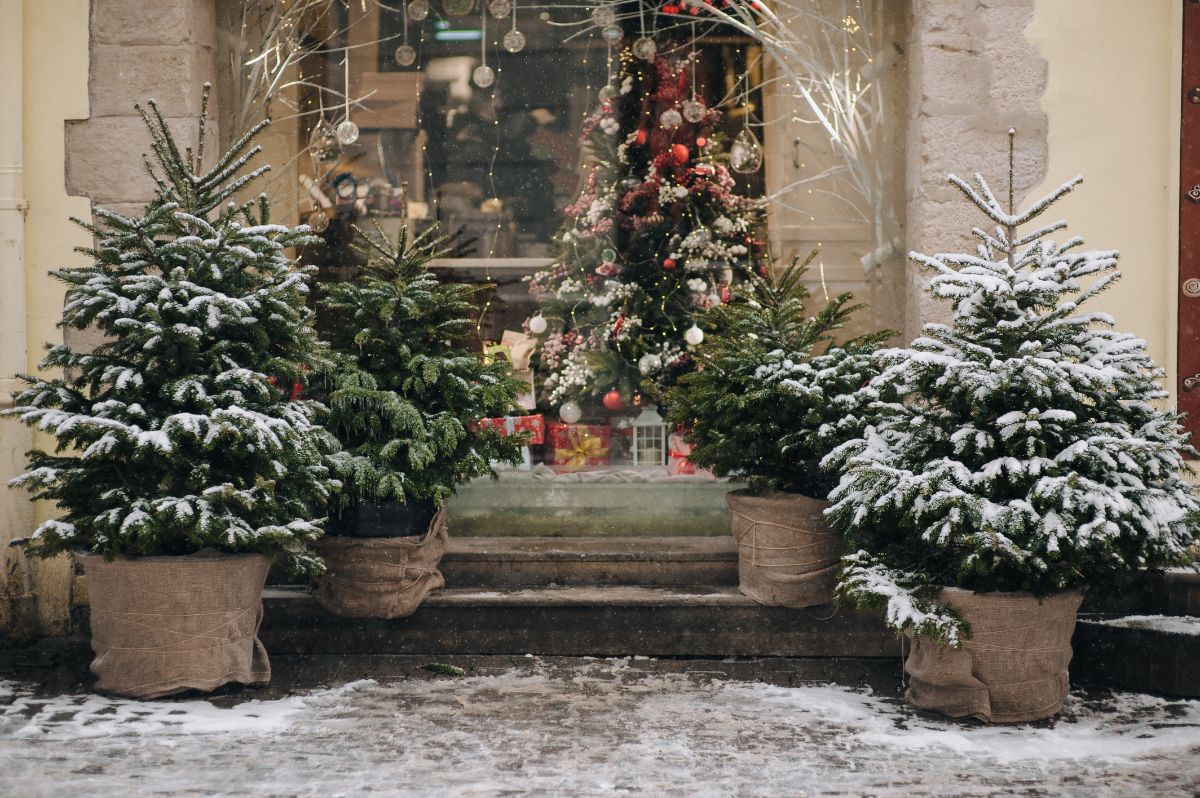
This mainly depends on how much yard space you have. Fortunately, there is a wide selection of conifers to choose from, both big and small, that can work for you.
Dwarf Trees That Make Great Living Christmas Trees
Pro: Dwarf conifers can stay in their pot for years if you take good care of them, and can serve as your Christmas tree over and over again.
Many dwarf species can be more versatile. Potted dwarf conifers can bring joy to your home year after year and can be kept in a pot all year.
In areas with cold winters, the pot should be kept in a sheltered area and insulated well with mulch to keep the roots from going through freeze/thaw temperature extremes. Water the tree on mild days.
Spraying your evergreens with anti-desiccants such as Wilt-Pruf or Bonide Wilt Stop is a valuable way to keep the plants from drying out.
The biggest danger to winter shrubs is drying out and not having water replenished. The anti-desiccant slows the rate of water evaporation through the needles, protecting the tree.
These products will give your needles a luster; when this luster fades, spray the anti-desiccant again.
Dwarf Alberta spruce (Picea glauca)

These are the most commonly used potted holiday trees because of their conical shape. Alberta spruces are also easy to grow. This will do best in cooler northern climates.
If your summer temperatures stay in the 90s for several weeks at a time, this spruce develops brown patches and fails to thrive. But she’s perfectly content in cold weather and cooler climates.
Norfolk Island Pine (Araucaria heterophylla)
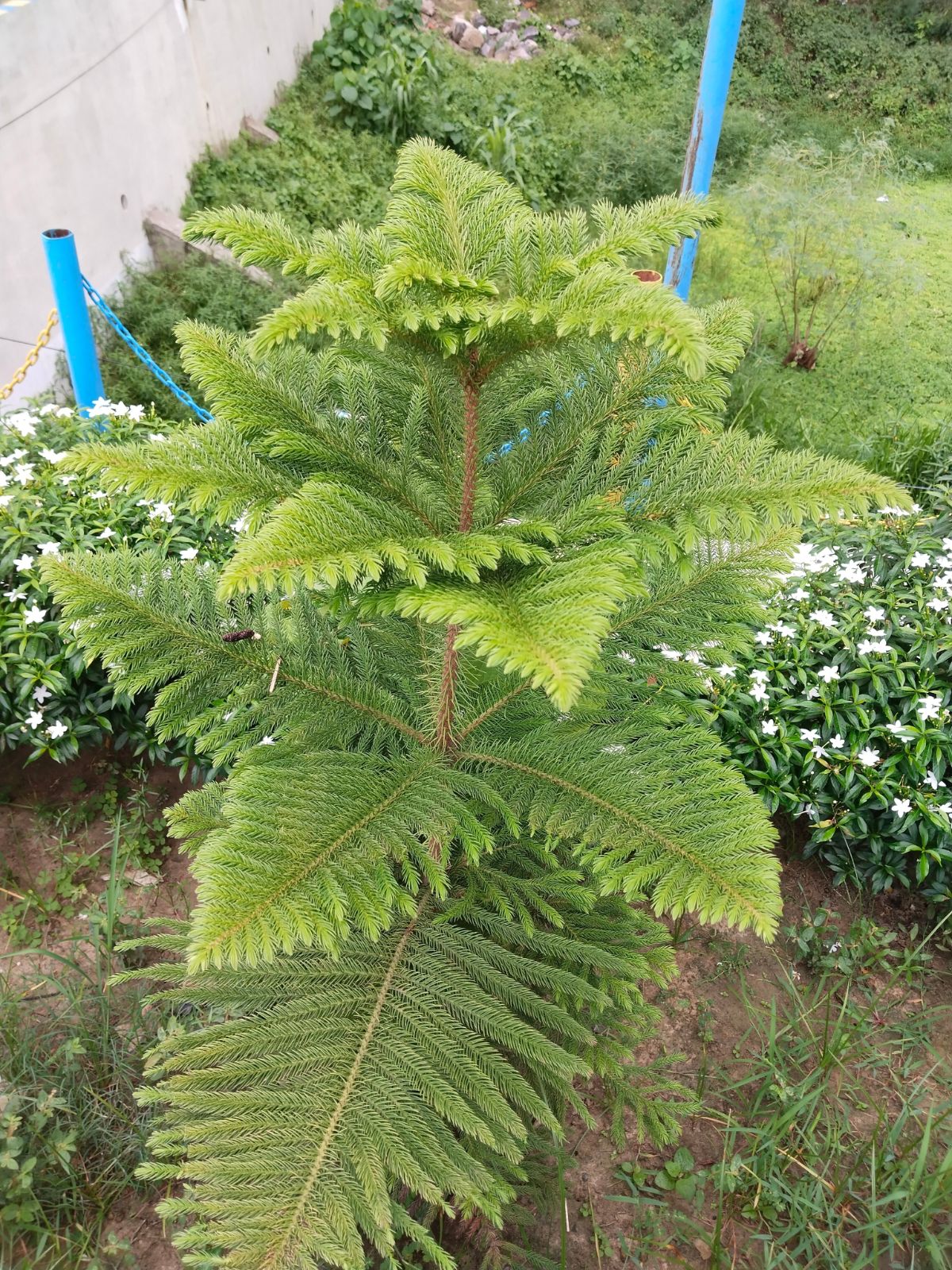
This little evergreen should be grown as a houseplant unless you live in a semitropical or tropical area. Don’t put this guy outside in the cold because it will perish! Norfolk Island pines need to stay mostly moist, though don’t let them stand in water. They like humid air due to their native habitat in the rainforests.
It will need full sun from one of your windows or a supplemental grow light. In summer it can go outside if you keep it in a brightly shaded area out of direct sun.
Other Dwarf Christmas Trees
Bosnian pine (Pinus heldreichii) ‘Compact Gem’
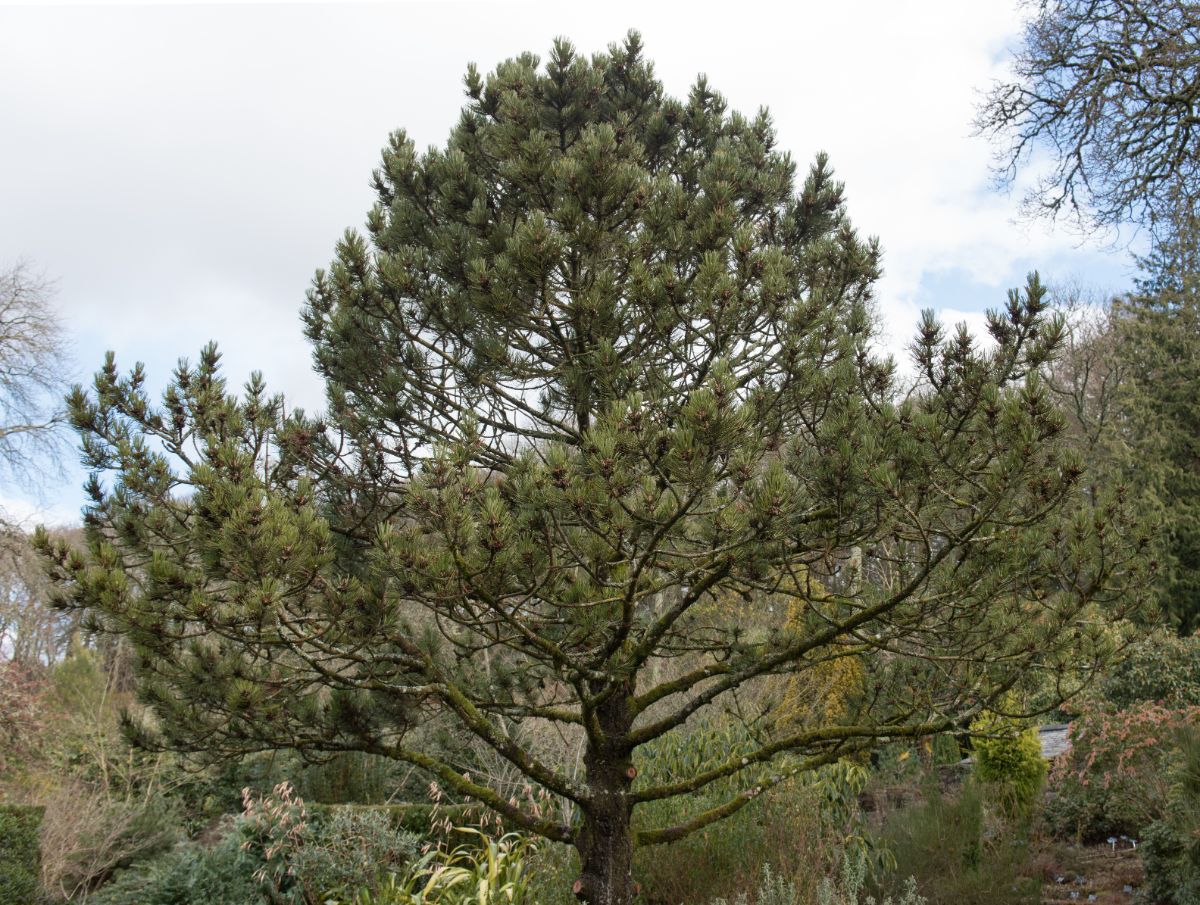
- A lovely tree native to Italy and the Balkans
- 12’ tall, 8’ wide
- Winner of the Award of Garden Merit from the Royal Horticultural Society.
- Hardy to Zone 6
Sawara cypress (Chamaecyparis pisifera) ‘Soft Serve’
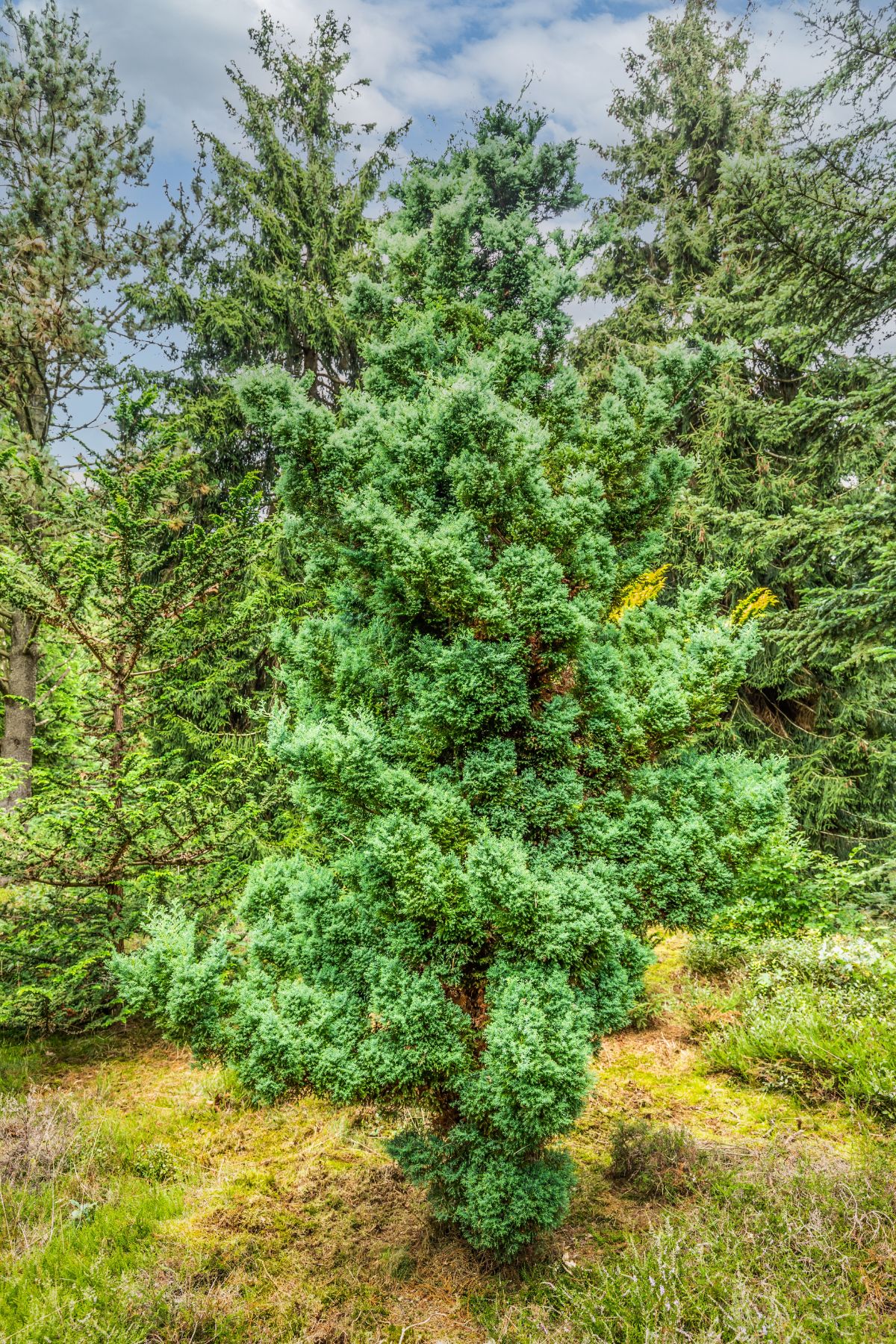
- A striking and graceful substitute for Alberta spruce with ferny branches of blue.
- 6’ to 10’ tall and wide
- Zones 4-8
Blue juniper (Juniperus scopulorum) ‘Wichita’
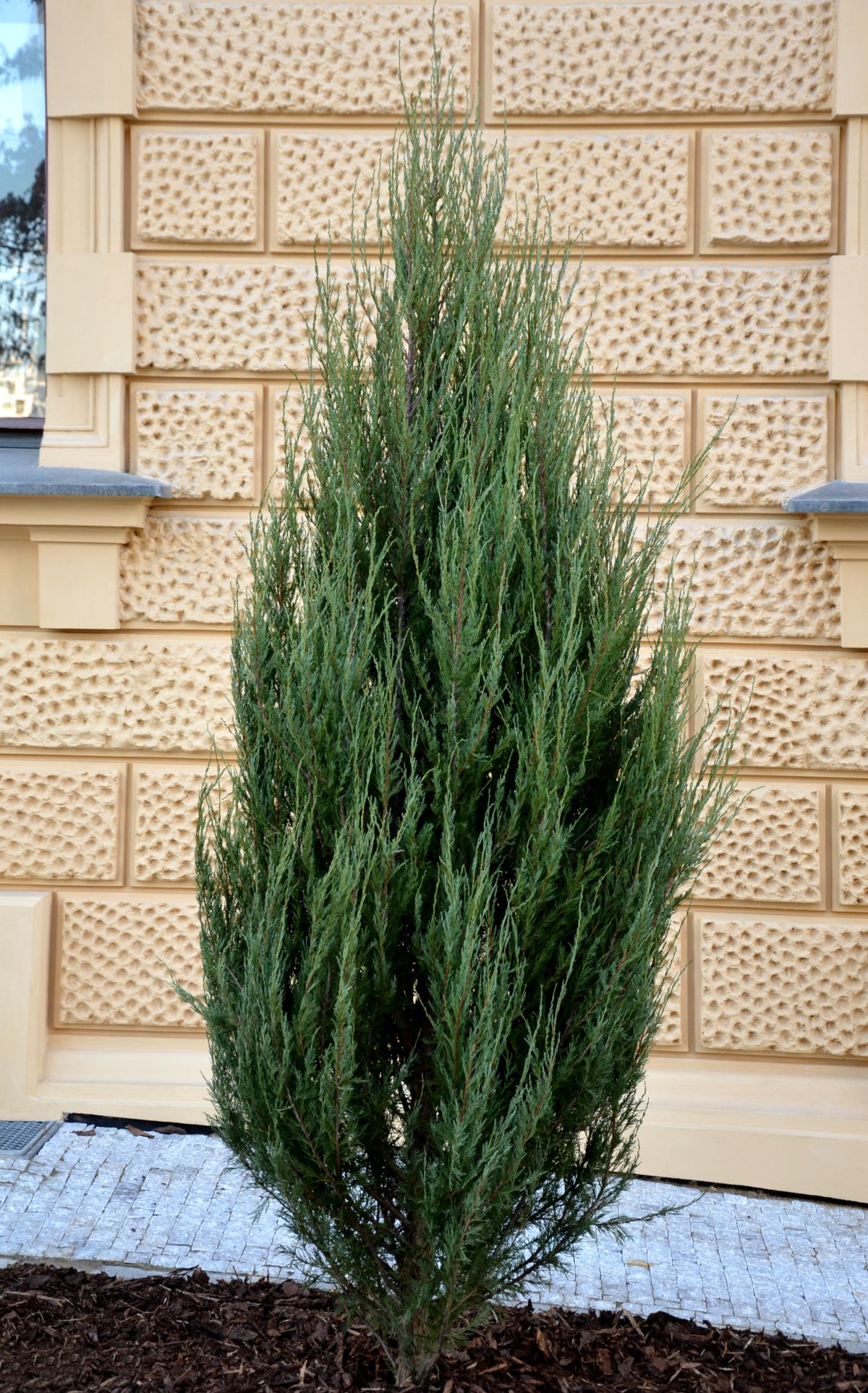
- A compact conical evergreen with blue foliage.
- Slow-growing, eventually reaching 15’ to 30’ tall.
- Zones 3-7
Norway spruce (Picea abies) ‘Pusch’
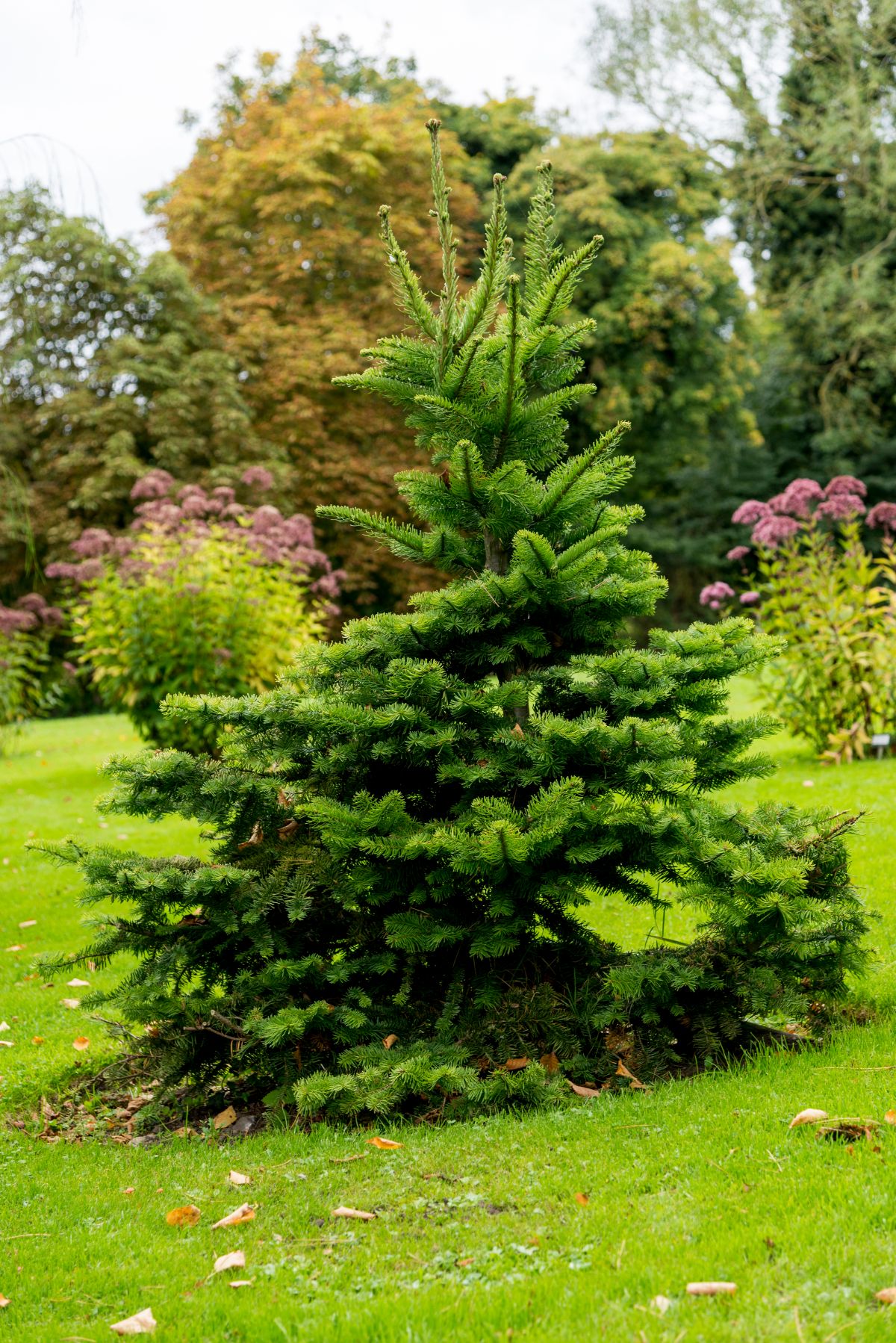
- A pretty gem of a spruce with tiny red cones.
- 2’ tall, 3’ wide
- Zones 3-7
Oriental spruce (Picea orientalis) ‘Firefly’
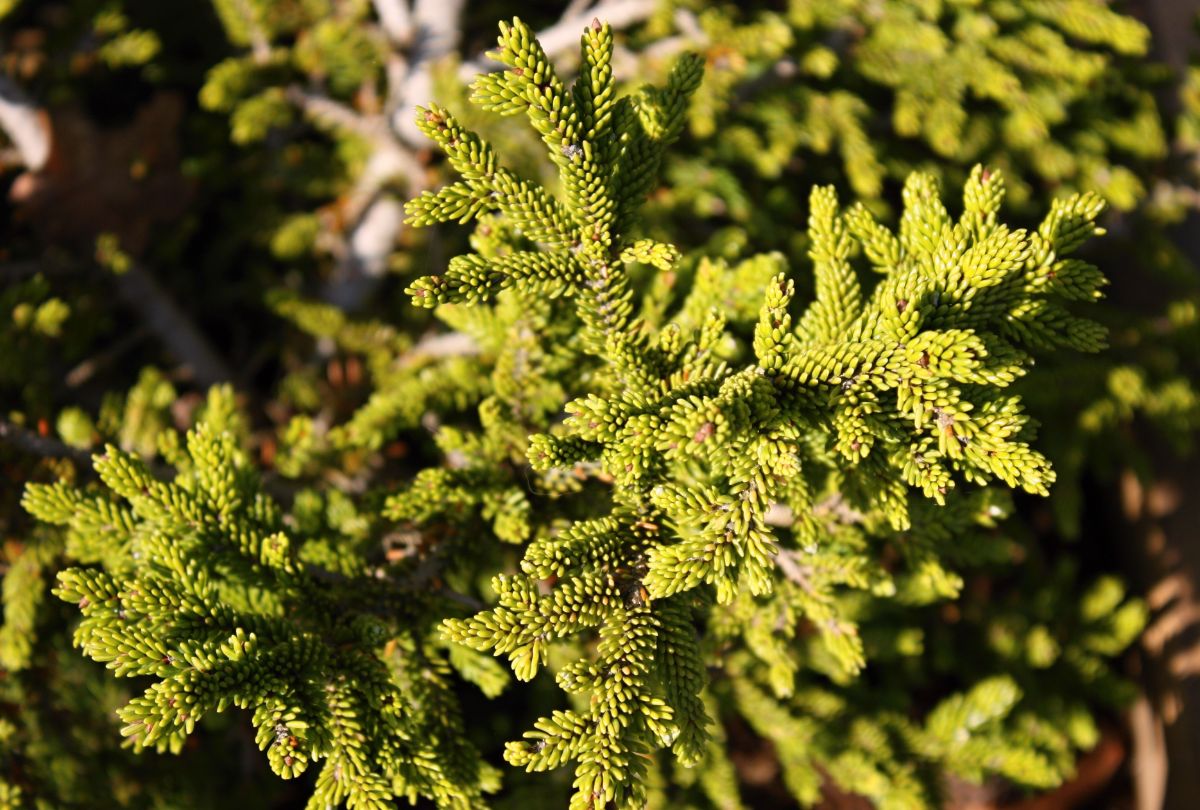
- Forms a dense conical shrub with yellow-green foliage
- 6’ tall, 4’ wide
- Zones 4-8
Think Ahead Before Buying a Large Tree!
If you get a large tree, it’s going to be more than a Christmas tree – it will also become a permanent fixture in your backyard.
- Make sure the tree is hardy for your area so you can plant it outside.
- Make sure it’s not too big for your house. You want it to fit through your doorways!
- Make sure it will be light enough to carry out of the house at the end of the season, even with a well-watered rootball.
- Make sure you’ve dug a place to plant the tree before the ground freezes.
- Put the soil from the hole in a protected area, like a shed, so it doesn’t freeze.
- Fill the hole with mulch such as straw or wood chips.
- Then at the end of the season, you can plant the tree.
Choosing an Evergreen with a Large Mature Size
Pro: It’s easier to pick up a 4 to 6-foot tree that can be decorated for this year’s Christmas tree when you buy a spruce, fir, or pine tree at the local nursery.
Pro: These trees can be kept in their pot for a year or two until they start to outgrow it.
Pro: These large evergreens can be taken out of their pot and planted in the yard, serving as a permanent reminder of the happy Christmases you spent with it.
Con: You will need a lot of yard space when you finally need to plant one of these trees.
Many spruce, fir, and pine trees could grow to be 60 to 70 feet tall and over 30 feet around, so they’ll need to be planted well away from the house.
Pro: However, if you have a lot of space, plant these trees and make a windbreak. These mature trees can block strong winds and snow, create a calm zone around your house and yard, and raise the winter temperature in this area.
Large Trees That Can Be Planted Outdoors

If you choose to grow these conifers, be sure you have a very large space to plant them in. Most of these will need 40 to 60 feet of space – so plant them well away from the house!
Grand Fir Abies grandis (best for cool northern climates)
Noble Fir Abies procera (best for cool northern climates)
Sitka Spruce Picea sitchensis (best for cool northern climates)
Scotch Pine Pinus sylvestris(not recommended in the midwestern United States or Europe due to pine wilt and pitch canker disease outbreaks)
Douglas Fir Pseudotsuga menziesii– The classic Christmas tree.
Western Hemlock Tsuga heterophylla – These can grow to be 60 to 100 feet tall, so give them a LOT of space!
I’m Putting a Living Christmas Tree in My House. What Could Go Wrong?
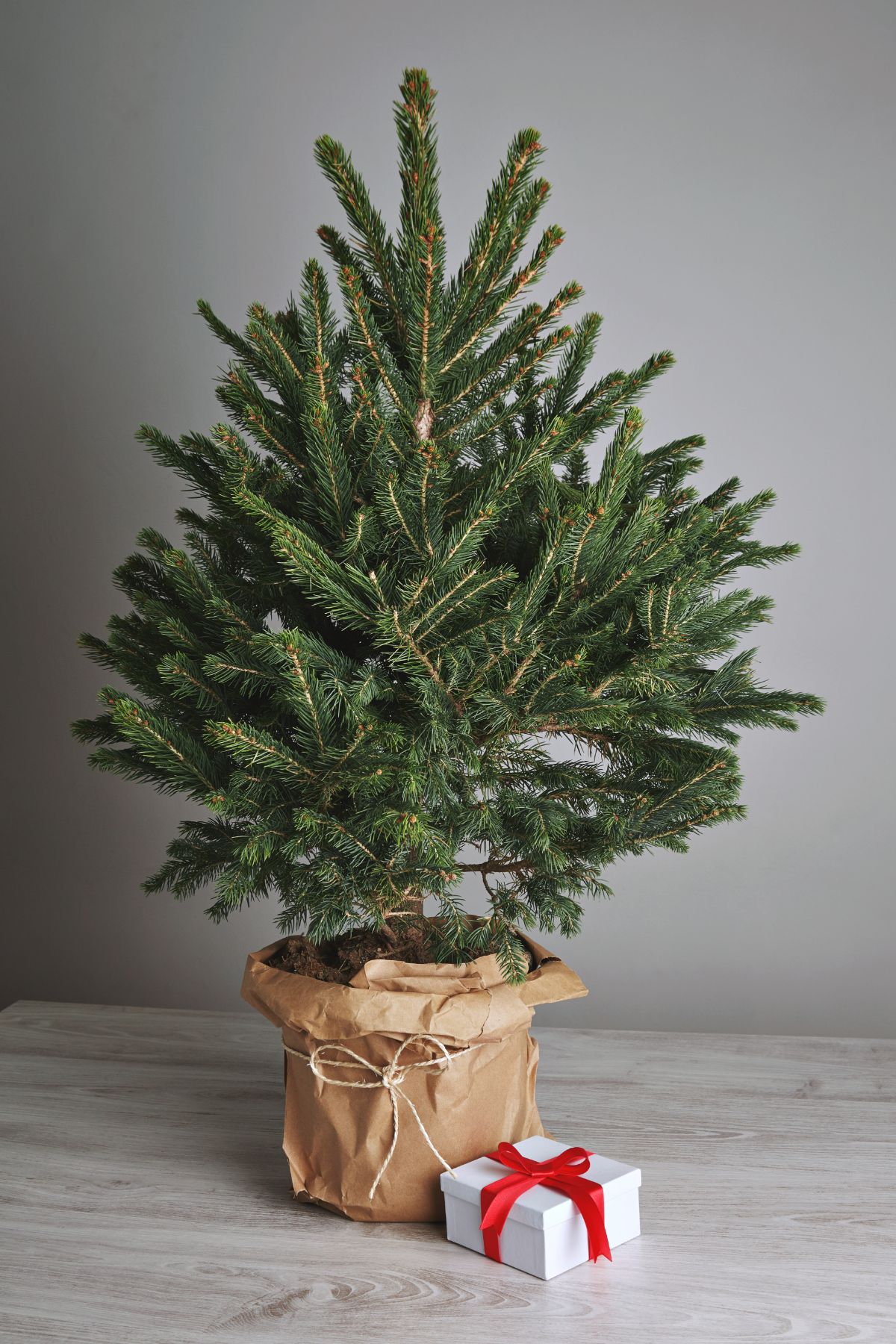
Sometimes, living Christmas trees sometimes don’t survive after the holidays. This can be due to several factors.
- The evergreen isn’t hardy to your area. For instance, if a Norfolk Island Pine was used as a tabletop Christmas tree in the northern United States and then planted outside, it would swiftly perish in the cold. This little tree is a subtropical denizen that cannot tolerate temperatures below 35 degrees.
- The living Christmas tree dries out while it’s indoors. Even just one missed watering can stress the tree to a point where it’s unable to recover. Large trees need more water, especially in a home with low humidity.
- If a living tree is left indoors for too long – over a week – then it’s no longer acclimated to the cold temperatures outside. When it’s taken outside, it can’t adjust to the abrupt change in temperature. You need to harden the tree off before moving it outside.
- Sometimes, large trees will undergo transplant shock because they lose water to the cold winter winds, but their roots are unable to pull water from the frozen soil to replenish themselves. Dormant trees do much better with winter planting than non-dormant trees.
- Other issues are due to rapid temperature changes and freeze damage in the bark and wood.
These might look like daunting issues – but as the Christmas angel said, fear not. There are ways to overcome each problem with a little forethought and planning.
What to Do When You Bring Home Your Living Christmas Tree
Here is how to give your tree the best shot possible.
- When you bring the tree home from the nursery or the store, give your tree a couple of gentle shakes to knock off loose needles.
- Take it out of its decorative container and put it in the sink or shower, then spray it with cool water to wash off dust and dirt. Let it dry.
- Next, spray your tree with an antidessicant such as Wilt-Pruf or Bonide Wilt Stop. Spray it thoroughly over all parts of the tree, over and under the stems. (Be sure to read and follow label instructions.)
These products will give your Christmas tree needles a little shine. Second, and more important, this waxy coating will slow water loss via evaporation in your tree. This will make a huge difference for your tree, both indoors and outside.
- Place your living Christmas tree in a cool spot that’s between 40-70 degrees F (3-20 degrees C). Lower your thermostat a little bit if you need to, or open a nearby window just a crack to keep the room cool.
- Make sure there’s plenty of space around the tree and plenty of light. The tree will need sun through the day – a few hours of morning or evening sun would be ideal.
- Choose a large, leak-proof pot or container that your tree’s pot or rootball will fit comfortably into. Place two bricks at the bottom to make sure your tree is not standing in water. Put the rootball in, then cover it with mulch (straw or woodchips) or newspaper to help keep the tree upright and keep it from drying out.
How to Make Your Potted Christmas Tree Thrive
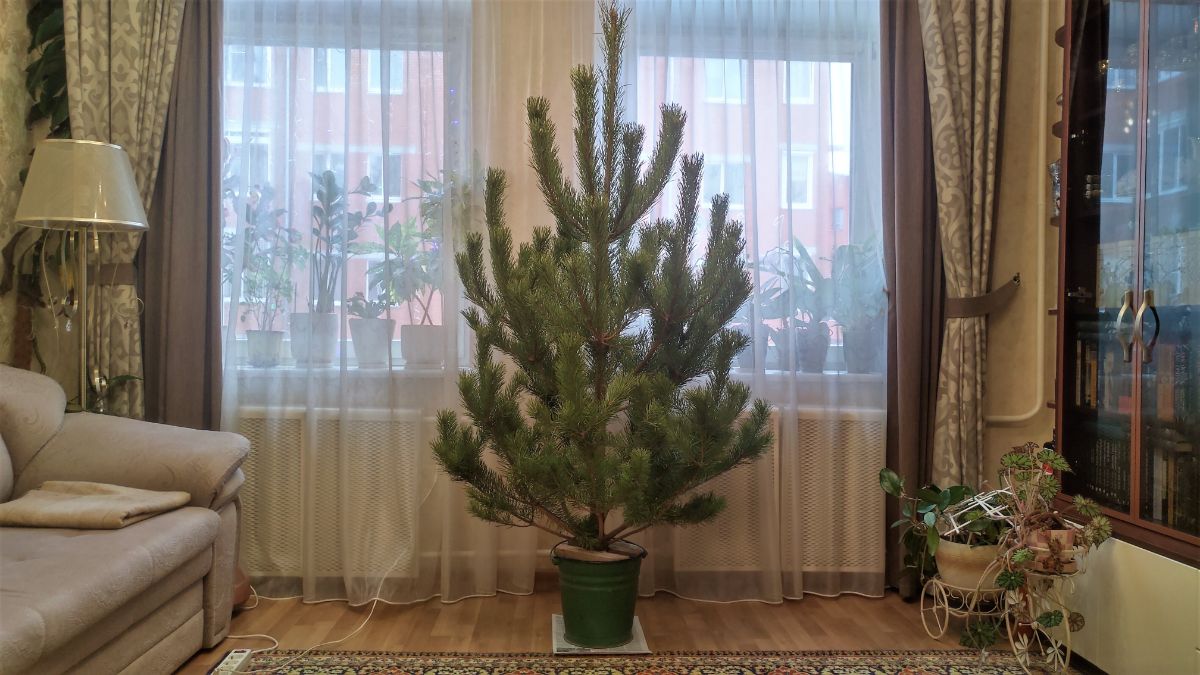
Keep the living Christmas tree away from all sources of heat – sunlight, fireplaces, heat vents, portable heaters, radiators, and so forth. These will pull water out of your tree.
Run a humidifier near the tree. Though winter houses should average between 30 to 50 percent humidity, living Christmas trees will need closer to 60 percent.
Water the Christmas tree often with tepid water. Wait for the top third of the pot to dry a little before watering again. If you have a small tree, simply lift the pot, and if it feels light, water again. Water all around the pot until water starts draining into the drainage container.
You can add a little fertilizer to the water to give the tree a small boost, but make sure it has little to no nitrogen. Nitrogen encourages new, green growth that would quickly get frozen outdoors.
Watch for drooping boughs and dropping needles – signs of severe dryness. Make sure the tree is getting enough to drink, but also make sure its roots are not standing in water. Turn the humidifier on the tree.
Keep your tree indoors for no more than a week. You want to make sure the tree doesn’t wake up enough to start forming buds. This new growth won’t survive in the cold outside. If the tree buds out, then its chances of surviving the winter decrease.
Acclimating Your Evergreen to the Outdoors
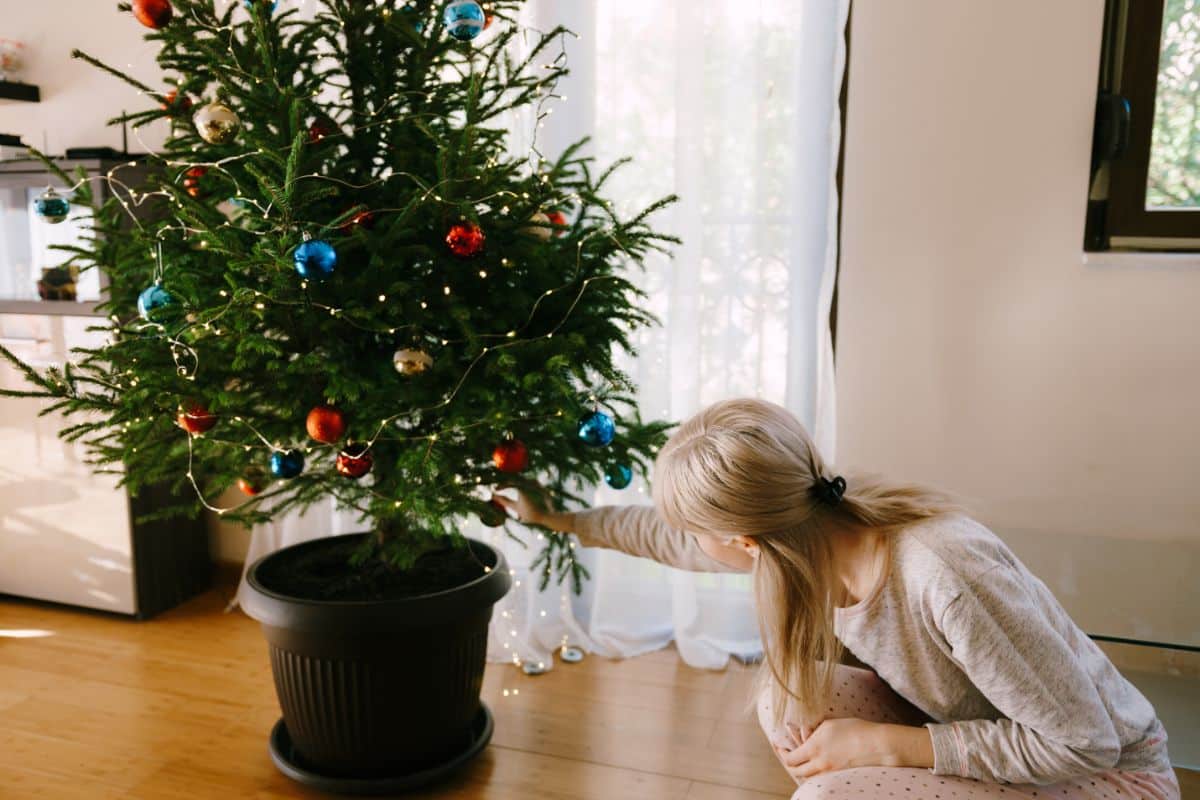
When the Christmas season is over, give your tree time to acclimate to outdoor temperatures.
Put your tree in an unheated garage for several days or a week, where it’s protected from the wind and cold. If you don’t have an unheated area, keep it under a tree or under the eaves of your house to protect it from the worst of the cold and snow.
If it’s in a dark garage or shed, give it light (use a full-spectrum LED grow light if necessary) and make sure it stays watered. Don’t skip a watering, and don’t let the tree’s roots stand in water for long periods of time.
Protecting Your Tree’s Rootball Against the Elements

Mulch the pot to protect the roots
If you have a dwarf evergreen that you plan to keep in a pot, pile mulch around the pot to protect it and stabilize the temperature. The mulch will also help keep the water from evaporating out so quickly.
Planting trees in the ground
If you have a full-sized evergreen that you’re going to plant, then take it to the hole you prepared, take out the mulch, and put the tree in.
Bring over the wheelbarrow of soil that you’ve been storing in the shed, cover up the rootball, and water it in deeply.
Put the mulch from the pot and from the planting hole over the top of the soil all around the tree.
Caring for Your Living Christmas Tree for the Rest of the Winter
Keep an eye on your tree through the winter. On mild days, give it a drink of water if it hasn’t rained or snowed for a while. If the luster on the needles fades, spray it again with anti-transpirant.
Then step back and admire your Christmas tree, and enjoy your new family tradition.

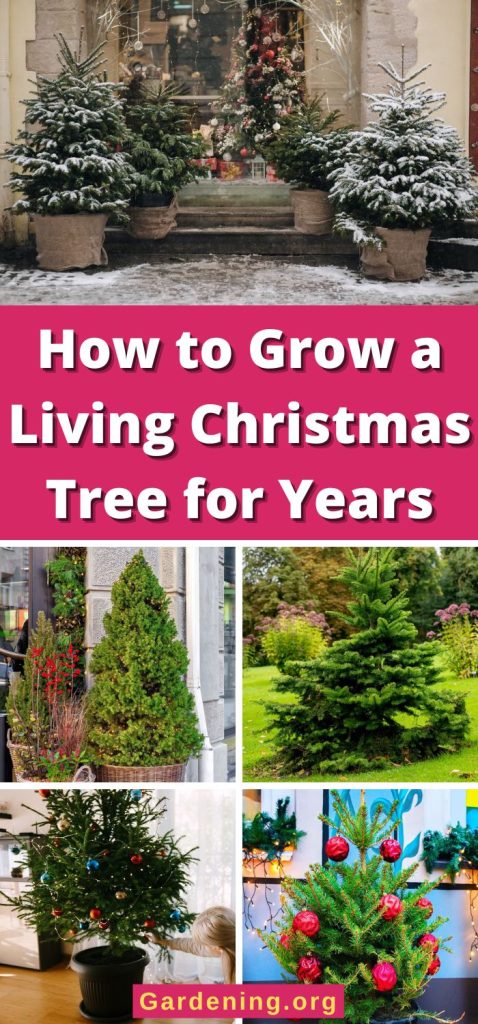
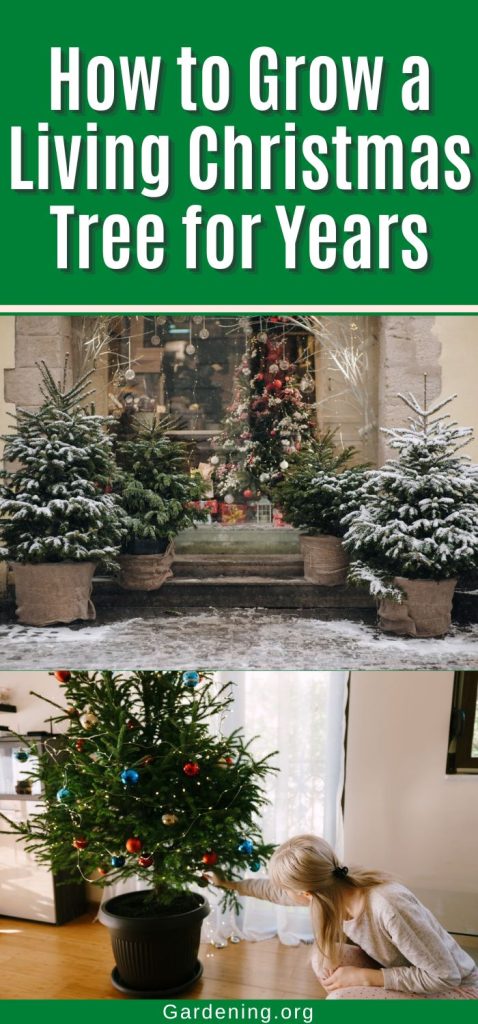
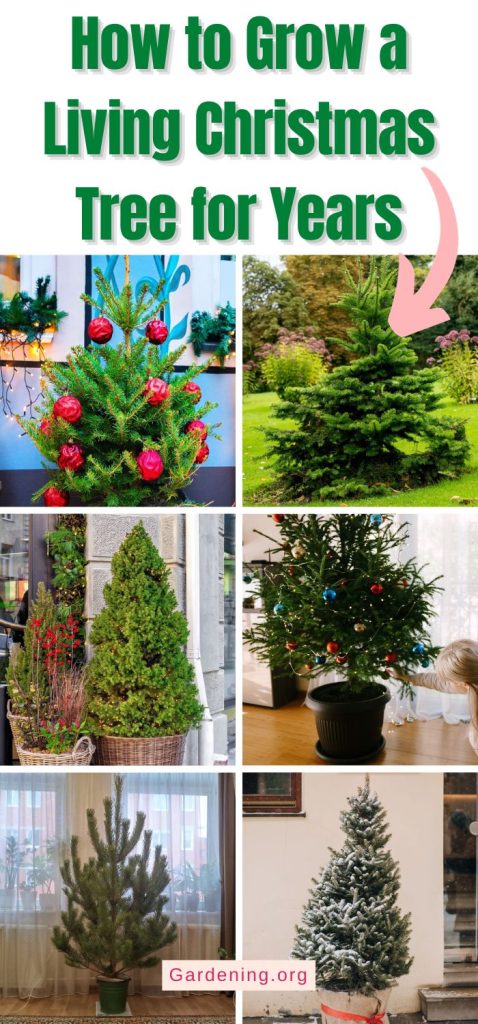
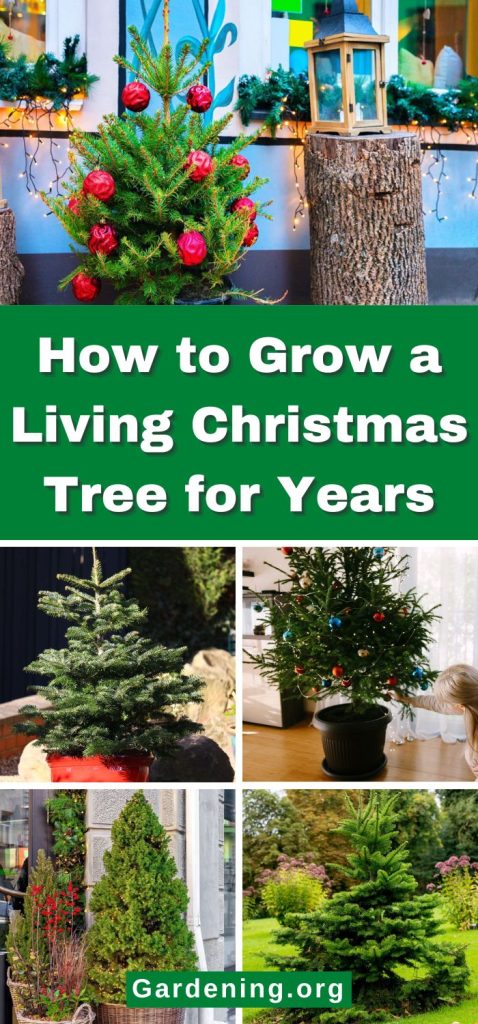
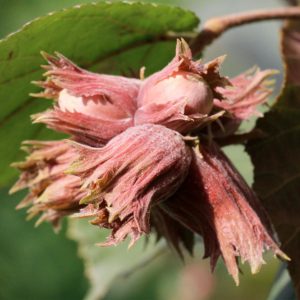
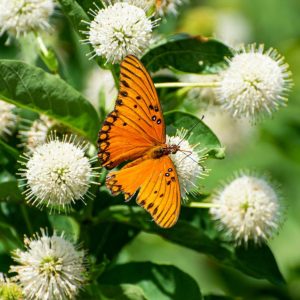
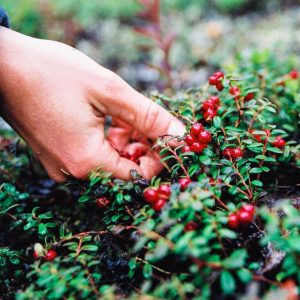
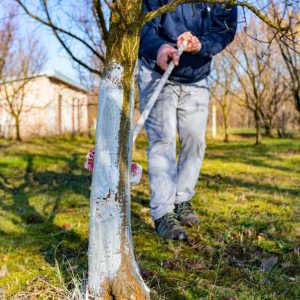
Leave a Reply